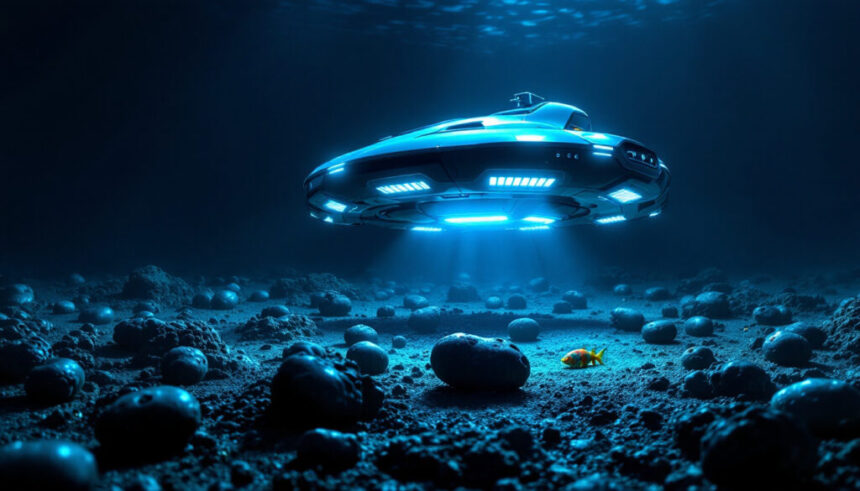As the world pivots toward clean energy, electric vehicles (EVs) have emerged as one of the most potent symbols of a greener future. Countries are pushing ambitious targets to phase out fossil-fuel-powered cars, and manufacturers are racing to electrify their fleets. But beneath this noble aspiration lies an environmental dilemma: the metals required to build EV batteries may come at the cost of destroying the Earth’s most untouched marine habitats.
This is the heart of a growing debate surrounding deep-sea mining. Vast mineral resources lie buried in the dark, remote depths of the ocean—nickel, cobalt, manganese, and copper—all critical components for manufacturing high-capacity lithium-ion batteries. As demand surges, mining companies, governments, and investors are eyeing the seafloor as the next frontier. Yet, scientists and environmentalists warn that extracting these metals may irreparably damage ecosystems we barely understand.
The Deep Sea: Earth’s Final Frontier
The deep ocean, often defined as areas below 200 meters, comprises more than half of our planet’s surface. It is a world of eternal darkness, crushing pressure, and extreme cold, but it also teems with life—from delicate corals and ghostly jellyfish to ancient sea cucumbers and bioluminescent fish.
These habitats have remained largely undisturbed for millions of years, evolving in isolation with extraordinary biodiversity. Seamounts, hydrothermal vents, and abyssal plains are home to species found nowhere else on Earth. And many are still unknown to science.
But it’s exactly here—thousands of meters below sea level—that polymetallic nodules, potato-sized rocks rich in nickel, cobalt, and manganese, are scattered across the seafloor. Especially abundant in the Clarion-Clipperton Zone (CCZ), a stretch between Hawaii and Mexico, these nodules have sparked a new gold rush.
Mining the Deep: Technology and Risk
Unlike land-based mining, deep-sea mining involves using remote-controlled machines to vacuum up nodules from the ocean floor. The nodules are pumped to surface vessels, leaving behind clouds of sediment and potentially damaging fragile ecosystems. The technology is still experimental, but several companies, notably The Metals Company and partnerships involving Pacific island nations, are pushing for commercial-scale operations.
Proponents argue that deep-sea mining is a necessary evil. They claim it can be cleaner than land mining, which often involves deforestation, pollution, and human rights abuses. By tapping the ocean, we might reduce geopolitical tensions over rare minerals, ensure supply chain security, and accelerate the energy transition.
However, critics warn that this approach risks repeating the same extractive mistakes of the past, now in an even more vulnerable and poorly understood environment.
Environmental Concerns
The sediment plumes created by mining can smother seabed organisms, clog filter feeders, and disrupt critical ecological processes. Species that live attached to or in close proximity to nodules may be wiped out, potentially pushing some into extinction.
Research also suggests that recovery from such disturbances, if even possible, could take centuries or longer. A 26-year study by the German research institute GEOMAR showed that tracks left by a small test mining operation in the 1980s remained visible and biologically barren decades later.
Moreover, the noise, vibration, and light from mining equipment can disturb marine mammals, such as whales and dolphins, that rely on echolocation. And the disposal of waste materials—known as tailings—back into the sea could create toxic conditions in the water column.
The deep ocean also plays a role in carbon storage. Disturbing the seafloor could release sequestered carbon, undermining efforts to combat climate change.
Race Against Regulation
The International Seabed Authority (ISA), the UN-affiliated body responsible for regulating mining in international waters, is currently under immense pressure. Despite limited scientific data and environmental assessments, the ISA has received dozens of applications for exploration licenses and is drafting rules for commercial exploitation.
Some nations, including Nauru and the Cook Islands, are partnering with mining firms, viewing seabed resources as a path to economic development. Others, such as France, Germany, and Chile, have called for a moratorium or ban, citing environmental concerns.
More than 700 marine science experts and conservation organizations have signed petitions urging a halt to deep-sea mining until further research is conducted. They argue that the potential benefits do not outweigh the irreversible damage.
The Clean Energy Paradox
The dilemma reflects a broader paradox in the climate transition. We need vast quantities of minerals to build EVs, wind turbines, and solar panels—yet extracting them often harms the very environment we’re trying to save.
This has prompted calls for alternative solutions: developing battery recycling infrastructure, reducing the demand for raw materials through innovation, improving public transportation, and investing in battery technologies that require fewer or no rare metals.
Companies like Redwood Materials and Ascend Elements are exploring advanced recycling methods. At the same time, researchers are investigating sodium-ion batteries and other alternatives that could reduce dependence on cobalt and nickel.
Voices from the Pacific
Perhaps the most affected, yet often least heard, are the voices of Pacific Island communities. For nations like Kiribati, Tonga, and the Cook Islands, deep-sea mining promises revenue and development. But it also threatens fisheries, traditional ways of life, and marine biodiversity upon which they depend.
“We are custodians of the ocean,” said a Fijian activist during a UN conference. “What happens to the sea happens to us.”
Local communities have called for greater transparency, representation in decision-making, and respect for indigenous knowledge systems.
Conclusion: A Choice for the Future
As the race for EV battery metals accelerates, the world stands at a crossroads. We can pursue a future that merely replaces one form of environmental degradation with another, or we can choose a genuinely sustainable path.
Deep-sea mining may offer short-term gains in the fight against climate change, but it also risks sacrificing some of the planet’s most pristine ecosystems. Before launching a new age of industrial extraction beneath the waves, we must ask: at what cost?
Will the pursuit of a green revolution end up staining the deep blue?






